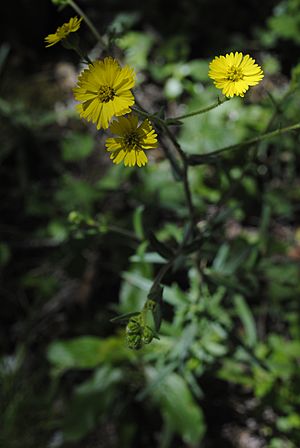Anisocarpus madioides facts for kids
Quick facts for kids Anisocarpus madioides |
|
|---|---|
 |
|
| Nature Reserve, University of California, Santa Cruz |
|
| Scientific classification | |
| Kingdom: | |
| (unranked): | |
| (unranked): | |
| (unranked): | |
| Order: | |
| Family: | |
| Genus: | |
| Species: |
A. madioides
|
| Binomial name | |
| Anisocarpus madioides Nutt.
|
|
| Synonyms | |
|
Madia madioides (Nutt.) Greene |
|
Anisocarpus madioides is a flowering plant from North America. It is also known by its common name, woodland madia. This plant belongs to the aster family, which includes many well-known flowers like sunflowers and daisies.
Where It Grows
This plant grows naturally along the west coast of North America. You can find it in British Columbia, Canada. It also lives in the US states of Washington, Oregon, and California.
Anisocarpus madioides likes to live in forests and woodlands. Most of these plants are found in mountain ranges. These include the Cascades and the Coast Ranges. They stretch from Vancouver Island all the way to San Luis Obispo County. Some plants are also found in the foothills of the northern Sierra Nevada mountains. Others are in the Agua Tibia Mountains in San Diego County.
What It Looks Like
Anisocarpus madioides is a plant that lives for many years. It can grow up to about 75 centimeters tall. Its stem is covered in rough hairs. It also has sticky glands that produce resin.
The leaves near the bottom of the plant can be up to 12 centimeters long. They grow in pairs, one on each side of the stem. The bases of these leaves are joined around the stem. The leaves higher up on the plant are much smaller. They often grow one after another along the stem.
The plant produces several flower heads. These flower heads grow on long stalks. Each flower head has a rounded base made of sticky, glandular leaf-like parts. The heads have yellow ray florets, which look like petals. These can be up to a centimeter long. There are also many disc florets in the center of the flower head.
After the flowers bloom, the plant produces small fruits. These fruits are called achenes. They are only a few millimeters long. Each fruit usually has a small, fluffy top called a pappus.

